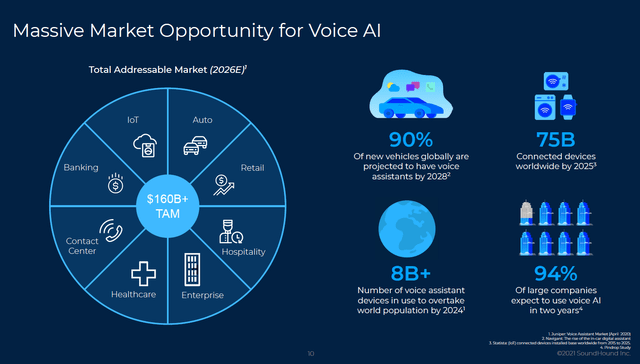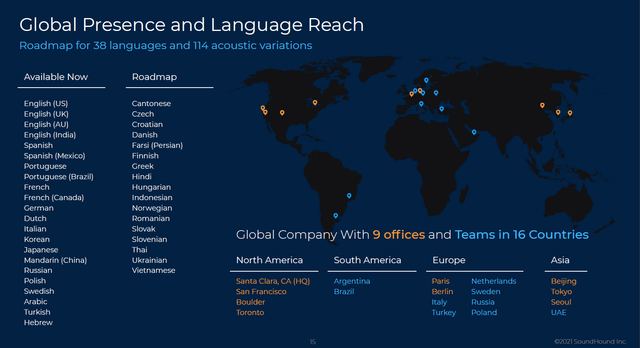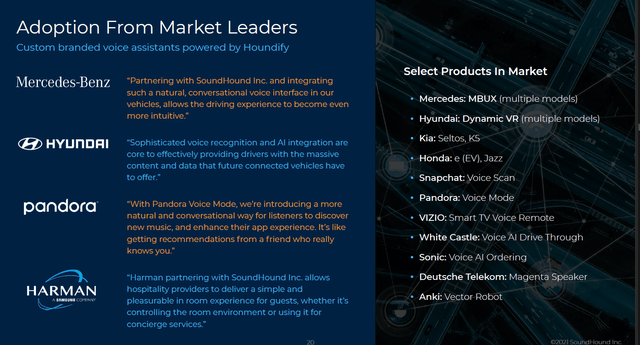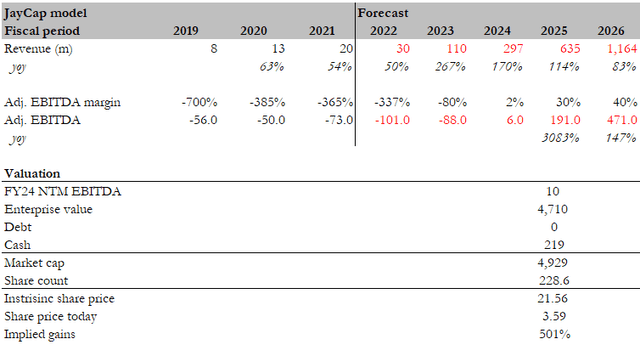
DKosig/E+ via Getty Images
Overview
SoundHound AI (NASDAQ:SOUN) is currently extremely undervalued. I believe there is huge potential for SOUN to be a meaningful winner in the industry it operates in, and the market will realize its value when it shows success in hitting guidance and winning more customers. Using management’s guidance, SOUN should generate $1.1 billion in revenue in FY26 and $471 million in adj. EBITDA, and at 10x adj. EBITDA in FY25 would yield investors a >5x return on their investments.
Business description
SOUN is a conversational intelligence pioneer, offering an independent Voice AI platform that enables businesses to provide conversational experiences to their customers. SOUN gives its customers access to Houndify®, an open-access platform that lets developers use SOUN’s Voice AI technology and a library of more than 100 content domains (SOUN S-1).
Significant addressable market
I think Voice AI has huge potential for widespread adoption, and the time seems to be right for SOUN as the world moves toward more automated products (vehicles, smart home systems, etc.).
To take advantage of the growing market for Voice AI, businesses in a wide variety of sectors are turning to third-party service providers with disruptive technology offerings for assistance in developing their own unique voice assistants. The demand for Voice AI is skyrocketing as businesses race to develop cutting-edge products. By 2028, it is expected that 90% of all new automobiles will include voice assistants, and by 2025, there will be 75 billion connected devices in use around the world. Even more importantly for SOUN, a study by Pindrop Security, Inc. found that 94% of large companies plan to use Voice AI within the next two years. This shows how seriously most businesses take the idea of a voice user interface.
Branded, individualized voice assistants help companies enhance customer experiences across the board. According to a recent Opus Research study, business leaders agree that voice assistants improve their customer service, which has meaningful value-add.
I believe the estimated 75 billion IoT devices in use by 2025 are likely to be too small to accommodate a keyboard or touch screen (compare the original Nokia to today’s iPhone), but they can certainly accommodate a small, cheap microphone. Businesses can give their customers greater internet access by incorporating Voice AI into their products via a microphone. AI with a human voice could make these inanimate objects interactive and intelligent. Experts’ forecasts show that this is a big market, with the total market for Voice AI transactions reaching over $160 billion by 2026 as demand rises across a wide range of industries.
The use of voice AI is rapidly expanding across a wide range of industries, and all of these represent huge revenue opportunities for SOUN.

SOUN Nov 2021 presentation
Proprietary innovations have strong value proposition
SOUN’s success in the Voice AI market is largely due to its technological breakthroughs. These include Speech-to-Meaning, Deep Meaning Understanding, and Collective AI, which are the three most important innovations.
The term “Speech-to-Meaning” is used to describe SOUN’s simultaneous and real-time translation of spoken words into their meanings. The standard practice has always been to first transcribe speech and then interpret it based on the written word. This approach may take longer or result in less precise results. The two processes are separated in time, making the total duration longer, and the additional processing time of the second process may be perceptible to the user. If an error occurs during the first stage of speech-to-text conversion, the erroneous text is then passed on to the second stage, and the process continues until the error is eliminated. SOUN’s technology recognizes speech and understands language at the same time when a user talks to it, which makes it faster to respond and more accurate.
SOUN’s approach to language understanding, Deep Meaning Understanding, enables its Voice AI platform to understand highly complex conversations. A complex search like this would take many minutes on a website with complex forms, but it can be completed in a matter of seconds using SOUN’s technology, which I believe is unique and extremely useful, especially for users that require large scale deployment.
Collective AI, SOUN’s third breakthrough, is an architecture that boosts the platform’s understanding potential exponentially from linear inputs. Most other platforms only add new, isolated skills or domains that don’t work together. Their understanding will expand at a linear rate, which is less scalable than other methods. The Collective AI architecture allows the various AI domains in SOUN to communicate with one another and gain knowledge from one another. As more developers work on a platform, its ability to understand can grow at a geometric rate.
Strong base of global customers that improve SOUN’s creditability
The truth is that it is difficult to judge the efficacy of an AI vendor’s offering; therefore, having a roster of notable clients (like Mercedes-Benz and Hyundai) and millions of users lends credibility to the vendor. Small and large companies alike from the automotive, IoT, app, restaurant, and other sectors are among SOUN’s clientele. Many of SOUN’s international clients, who serve customers in a wide range of sectors and locales, have found success in deploying SOUN products in a variety of settings and with a wide range of objectives.
Millions of people have access to SOUN’s technology because of the company’s deep AI partnerships with market leaders. By the end of 2021, the company’s monthly query volume had surpassed 100 million, and the total number of queries had surpassed 1 billion. In addition, 2022’s first-half traffic levels were higher than 2021’s at the same time levels. Over a billion people are currently using SOUN products, as reported by SOUN’s strategic partners.

SOUN Nov 2021 presentation

SOUN Nov 2021 presentation
High barriers to success
The fact that Voice AI has a high barrier to success and that there aren’t many companies offering complete solution platforms is one of the key reasons I like SOUN’s. Firstly, it takes a long time and a lot of money to develop all the parts of Voice AI. Afterwards, more effort and money are needed to make the solutions marketable, fully formed, and competitive. Lastly, a sizable sum is needed to localize the solution in various languages and regions around the world.
Forecast
Based on my investment thesis, I expect SOUN to be a meaningful winner in the automotive AI space, which should translate to meaningful profits in the future. My thesis ultimately lies in the fact that AI will be a game changer, and with that premise in mind, I believe SOUN is able to hit management guidance in FY26.
In my model, I expect SOUN to start growing at very high rates from 2023 onwards, reaching $1.1 billion in revenue and $471 million adj. EBITDA in FY26. The tricky part here is what valuation multiple to use since there are very few comparable in the market. That said, it is better to be conservative, hence I used Cerence (CRNC) and Nuance Communication historical multiples as a benchmark and assumed that SOUN trades at 10x EBITDA in FY26. Note that SOUN should continue to grow at very high rates so it can trade at a higher multiple. Based on the above assumptions and an NTM EBITDA of 10x, I came up with an intrinsic value of $21.56. This is 5x more than the current share price of $5.60. (This sounds high, but it was trading as high as $16 just a few months back).

Author’s estimates
Red Flags
Extremely competitive market
While I did say that there are significant challenges to becoming successful in this field, that doesn’t mean breaking in is impossible. Numerous businesses either already have or have plans to launch products that compete in the growing field of voice-activated artificial intelligence. Customers, both current and potential, may opt to work with SOUN’s rivals who offer superior products by creating competing products or forming strategic alliances with them.
Revenues are concentrated on large automobiles OEMs
In the future, SOUN’s customers, particularly those in the automotive industry, may put pressure on the company to lower its prices, given that they have huge buying power.
Sensitive to interest rates environment
Because there are no meaningful profits in the near term, the majority of SOUN’s value is in the future (FY26). As a result, the current share price is extremely sensitive to changes in interest rates; investors should expect high volatility in the near future until SOUN shows meaningful success in meeting guidance.
Conclusion
SOUN is extremely undervalued at its current share price as of the date of this writing. I believe SOUN is a leading player in this industry due to its technology innovations and adoption by millions of users. This is a very big industry with a lot of revenue opportunity for SOUN if it can continue executing well and acquire more customers. I don’t think SOUN’s current market value shows what it’s really worth, mostly because it is not generating meaningful profits today and investors seem to favour cash flow positive businesses. This looks like a good time to buy if you think SOUN can meet its guidance for FY26.


Be the first to comment